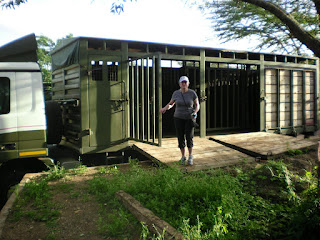Wednesday, January 9,
2013
Elephants, Kasarani,
and BioSand Water Filters
Elephants: more about the plight of elephants at
Sheldrick Wildlife Trust refuge and in the wild.
Right now there are 25 baby orphan elephants, ages 6 months
or so to 3+ years, at the refuge. The pens
are nearly full and many more baby elephants are expected to arrive in the
coming months due primarily to poaching and drought. The dry season has started in Kenya and
little if any rain is expected through March.
Although true drought is regional, the dry season is accompanied by lack
of food for elephants throughout the country.
The largest national parks, Tsavo and Tsavo East, are already
experiencing drought and withered vegetation.
The dry weather in the Tsavos affects the elephants there
and it affects the orphans in Trust refuge hundreds of miles away in the outskirts
Nairobi. Normally, the three year old
elephants in the refuge would already have been transferred for care and
reacclimation to the semi-wild at Ithumba in Tsavo East. But they have been held back due to lack of
natural food at Ithumba. After three orphans
are transferred this week or nextby truck, their food will have to be supplied by the
keepers at Ithumba, at least until the rains return in the spring. Others will be transferred from Nairobi only when they can be assured of plentiful
natural vegetation or when no space whatsoever is available in Nairobi. This is the truck.
The dry weather affects the native wild elephants as
well. When there is little or no food,
they expand their foraging ranges, often to land and villages which surround
the national parks and wildlife sanctuaries.
The local human residents resent this and often take their resentment
out on the elephants intruding their shambas and farms. Older elephants are snared, poisoned, speared
and killed, and any young ones that escape are left on their own. For those still nursing from their mothers,
this means certain death unless they are rescued by humans. Those young elephants not nursing become
easier prey for hyenas and cats.
All of this is on top of the even larger problem of poaching
adult elephants for ivory. The price of
ivory has increased nearly 100-fold in the last few years due to market demand
in China and eastern Asia. It’s hard to
stop the poaching when a poacher can make more money from just one elephant
than he could earn in a year of labor or farming.
Kasarani:
Each time we visit Kenya, this is our seventh visit in eight
years, we begin our trip with a short
stay at the Sportsview Hotel in Kasarani, a northern suburb of Nairobi. There we meet with our friends and Kenyan
CLOUT counterparts, Connie Ambasa Shisanya and Chris Shsanaya, to discuss the
past and plan for the future. When we
first came to Kenya some eight years ago, the short trip from the Nairobi
airport to Kasarani on rutted roads could take nearly two hours. Now, thanks to Chinese road builders, the
trip is only about 45 minutes long.
Roads all over Kenya have shown dramatic improvement in these
years. Our annual bus ride from Nairobi to
Kasavai in western Kenya used to be a bone-jarring 12-hour ordeal. Now, we expect only a 9-hour ride with only
an occasional jolt to the back.
Our brief stay in Kasarani gives us a chance to deal with
jet lag and to get reacquainted with the Kenyan culture, as well as make short
trips to local attractions like the National Museum, downtown Nairobi, the
Rothchild’s giraffe sanctuary, Karen Blixen’s homestead (Out of Africa), and
the memorial site of the 1998 US embassy bombing. We also enjoy short walks into the heart of
Kasarani. The streets of Kasarani are
generally dirt but can also be mud. The
road to the Sportsview from the main Kasarani/Mwili road is ¼ mile of
potholes. The Sportsview is an oasis
just up the road from buildings that are mostly under constant construction and
sewage that runs in in ditches next to the streets. Sounds like heaven, doesn’t it. We actually like it. It’s real with no pretence.
BioSand Filters:
Last night’s meeting with Connie and Chris at the Sportsview
was accompanied by a meal of local (translate as tough) chicken, goat (mbuzi)
meat, spinach, and rice, all washed down with generous portions of beer and/or
wine. Fine dining at its best.
Among things we discussed were ideas for what to do next to
help the HIV/AIDS widows of Kasavai escape poverty and disease on their way to
self-sufficiency. Typhoid, dysentery,
diarrhea, and other water-borne diseases are major health issues for the widows
and their families. We are going to try
a pilot water purification project of using a “Biosand” filtration system. For the pilot, we’ll have four biosand
filters installed around the village, one in the CLOUT/Watafutaji office/sewing
center/preschool and three in selected widows’ houses for use by them and their
neighbors. Each filter comes with
training on its use and maintenance. We
are told that the filters can last for 30 years with virtually no maintenance
if they are used properly. Each is a
concrete box about one foot square and four feet high containing gravel, sand, a
metal diffuser plate, and a syphon system.
They rely on the sand and naturally occurring bacteria on it to clean
the water of sediment and the majority of water-borne organisms, like e-coli.
The user pours water collected from a stream or roof in the top and
collects the same amount (in a clean container) immediately from the spout on
the side near the top (at a rate of about 1 liter per minute). There are no moving parts and nothing to
replace. Each costs about $50,
including installation and training.
Installation and training are planned for next week. We’ll let you know how it works out. And if it does, we plan on large scale
installation later.


















No comments:
Post a Comment